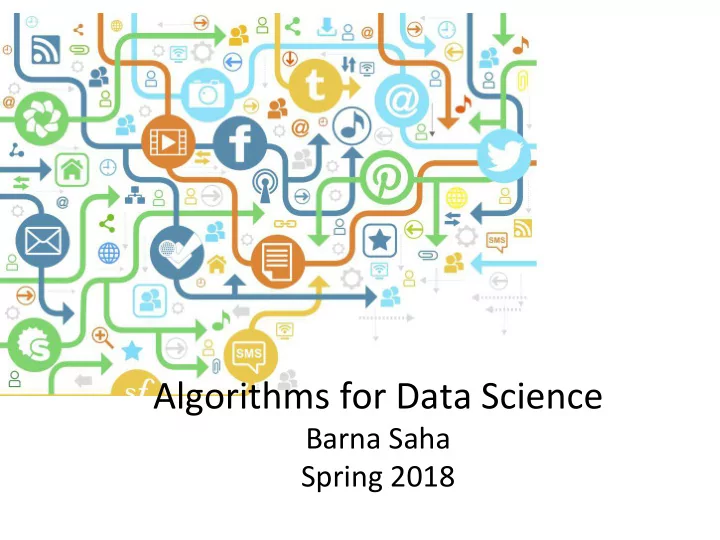

Algorithms for Data Science Barna Saha Spring 2018
A new algorithms class! • Why do we need a new algorithms class? – Unprecedented amount of data containing a wealth of informaAon. • Example: TwiGer receives 6000 tweets per second which amounts to 500 million tweets per day with a storage requirement of ~640 gigabytes. – TradiAonal algorithms process data in RAM, sequenAally and may have high Ame-complexity • Not suitable for processing TwiGer data
CharacterisAcs of Big Data • VOLUME – Can not store the enAre data in the main memory • VELOCITY – Data changes frequently. Needs highly efficient processing, o[en parallel processing. • VARIETY & VERACITY – Data coming from many different sources, and o[en contains noise-adds to the complexity of data processing
This Course • Develop algorithms to deal with such data – Space and Time Efficient – Parallel Processing – ApproximaAon & RandomizaAon • TheoreAcal course with main focus on algorithm analysis – Relevant applicaAons will be discussed, and there will be plenty of coding exercises – But no so[ware tools will be covered • Background in basic algorithms (311) and probability (240) are strictly required.
Personnel • Instructors & Teaching Assistants – Barna Saha • Email: barna@cs.umass.edu • Office Hour: Thur 12:45-1:45, CS336 – David Tench • Email: dtench@cs.umass.edu • Office Hour: Wed 2:00-3:00 pm, CS 207 – Raghavendra Addanki • Email: raddanki@cs.umass.edu • Office Hour: Mon 4:00-5:00 pm, CS207
Grading • Homeworks (3-4) in a group of 2 to 4 – Will consist of mathemaAcal problems and/or programming assignments – Find your partners early and wisely. Do not come to me with complaints about your partner. – 30% • Midterm [March 22 nd , in class] – 20% • Final [University schedule, May 3 rd ] – 30% • Mini Coding/Programming Assignments – Few simple exercises to be done individually – Roughly 4 – 20%
CommunicaAon • All class related discussions should be done through piazza. – Sign up from the course page. • Course website – hGp://www-edlab.cs.umass.edu/cs590d/ • Homework submission – Must be submiGed via moodle—no hardcopy submission – All codes must be submiGed via Moodle – Absolutely no submission by email
Books • Text Book: We will use reference materials from the following books. Both can be downloaded for free. • Mining of Massive Datasets, Jure Leskovec, Anand Rajaraman and Jeff Ullman. • FoundaAons of Data Science, a book in preparaAon, by John Hopcro[ and Ravi Kannan
An InteresAng Problem • Suppose we see a sequence of items, one at a Ame. • We want to keep a single item in memory. • We want it to be selected at random from the sequence. • Easy if we know the number of items “n” – Just draw a random number in between 1 and n • What if we do not know n?
Reservoir Sampling
Reservoir Sampling
Reservoir Sampling What happens when the reservoir can store “s” elements?
Reservoir Sampling!
Sampling • A very useful method to obtain appropriate summary of data • Will learn more in the coming classes • But needs to be done with care • Link to video hGps://www.youtube.com/watch? v=xmhVdsOTh1E
Mini Exercise-1 • Implement reservoir sampling when reservoir has size 1. Let the items from 1 to 100 appear one by one. – Report the item sampled in one run of the algorithm. – Repeat the algorithm for 1000 Ames and plot the number of Ames each element is selected. – Repeat the algorithm for 10000 Ames and plot the number of Ames each element is selected. – Repeat the algorithm for 100000 Ames and plot the number of Ames each element is selected. 2. Suppose n is the total number of items that arrived. Show that the probability of selecAng a parAcular set of s items in the reservoir sampling algorithm is 1 – DUE: Tuesday, 30 th .
Next Few Classes • Probability review before we enter into the more interesAng regime!
Recommend
More recommend